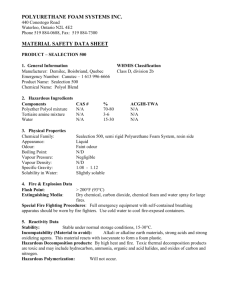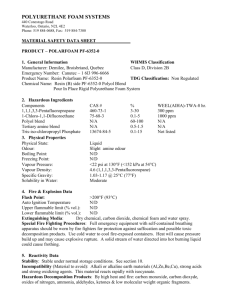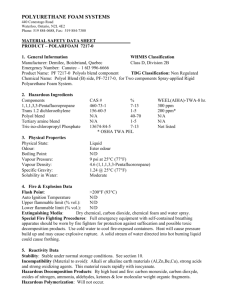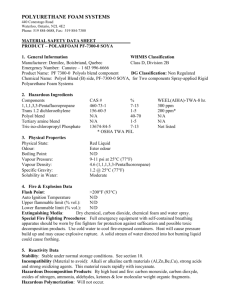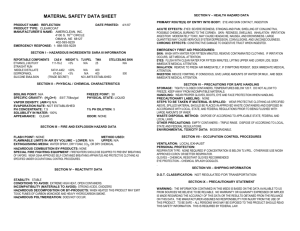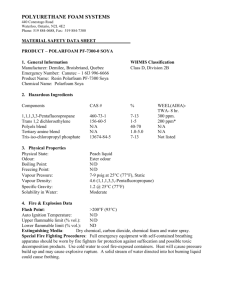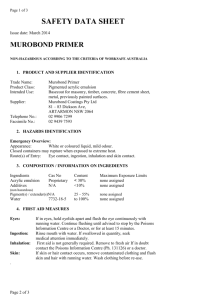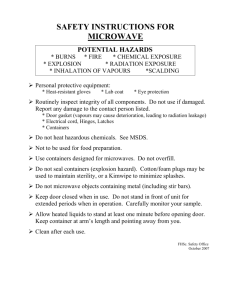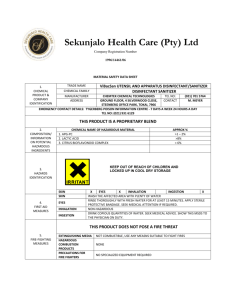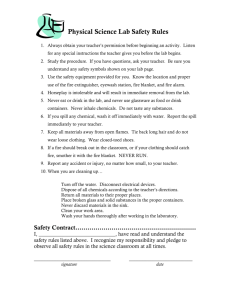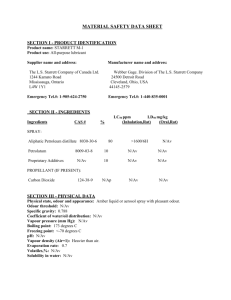POLYURETHANE FOAM SYSTEMS
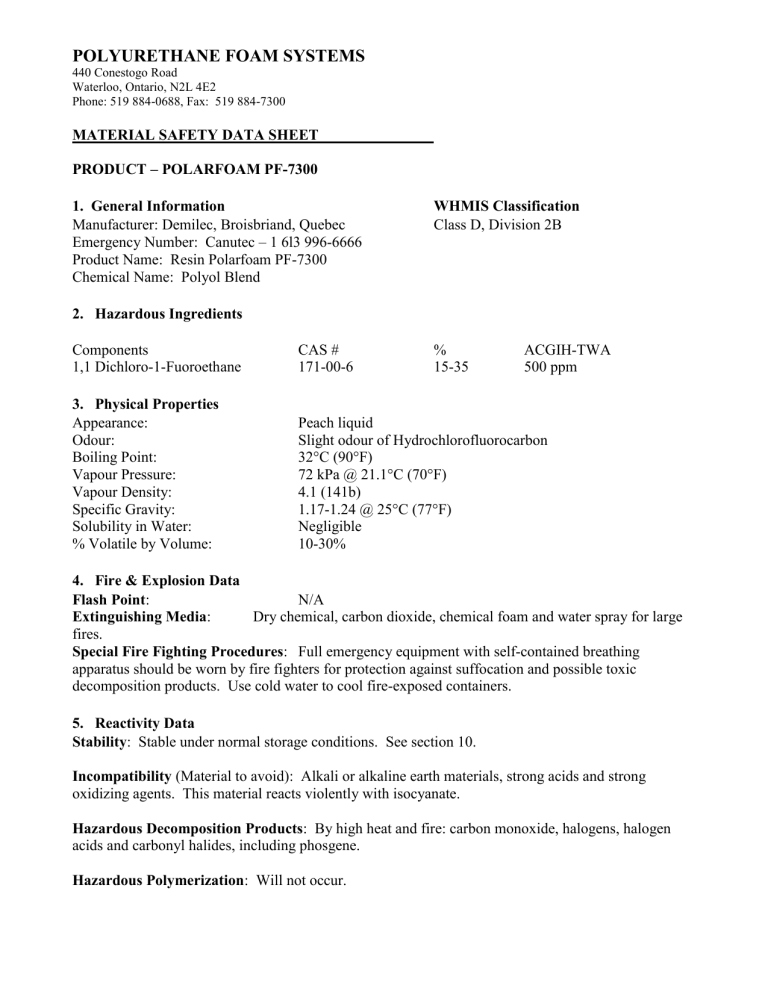
POLYURETHANE FOAM SYSTEMS
440 Conestogo Road
Waterloo, Ontario, N2L 4E2
Phone: 519 884-0688, Fax: 519 884-7300
MATERIAL SAFETY DATA SHEET
PRODUCT – POLARFOAM PF-7300
1. General Information
Manufacturer: Demilec, Broisbriand, Quebec
Emergency Number: Canutec – 1 6l3 996-6666
Product Name: Resin Polarfoam PF-7300
Chemical Name: Polyol Blend
WHMIS Classification
Class D, Division 2B
2.
Hazardous Ingredients
Components
1,1 Dichloro-1-Fuoroethane
3.
Physical Properties
Appearance:
Odour:
Boiling Point:
Vapour Pressure:
Vapour Density:
Specific Gravity:
Solubility in Water:
% Volatile by Volume:
CAS #
171-00-6
Peach liquid
Slight odour of Hydrochlorofluorocarbon
32°C (90°F)
72 kPa @ 21.1°C (70°F)
4.1 (141b)
1.17-1.24 @ 25°C (77°F)
Negligible
10-30%
%
15-35
ACGIH-TWA
500 ppm
4.
Fire & Explosion Data
Flash Point :
Extinguishing Media : fires.
N/A
Dry chemical, carbon dioxide, chemical foam and water spray for large
Special Fire Fighting Procedures : Full emergency equipment with self-contained breathing apparatus should be worn by fire fighters for protection against suffocation and possible toxic decomposition products. Use cold water to cool fire-exposed containers.
5.
Reactivity Data
Stability : Stable under normal storage conditions. See section 10.
Incompatibility (Material to avoid): Alkali or alkaline earth materials, strong acids and strong oxidizing agents. This material reacts violently with isocyanate.
Hazardous Decomposition Products : By high heat and fire: carbon monoxide, halogens, halogen acids and carbonyl halides, including phosgene.
Hazardous Polymerization : Will not occur.
6.
Health Hazard Data
Eye Contact : May cause eye irritation and corneal injury. May be slow to heal, with possible permanent impairment to vision.
Skin Contact : Moderately irritating, may cause redness, edema or drying of skin.
Ingestion : May cause nausea, abdominal pains, vomiting and diarrhea.
Inhalation : May cause light-headedness, giddiness, shortness of breath and possible narcosis.
Cardiac arrhythmia may develop at concentrations above the TLV.
7.
First Aid Procedures
Eye Contact : Flush with running water for at least 15 minutes, holding eyelids open. Obtain medical attention.
Skin Contact : Remove contaminated clothing. Wash affected areas with soap and water for at least
15 minutes. Wash contaminated clothing before reuse.
Ingestion : If conscious, give 250 ml of milk or water to drink and induce vomiting. DO NOT GIVE
ANYTHING BY MOUTH TO AN UNCONSCIOUS PERSON. Obtain immediate medical attention.
Inhalation : Remove patient to an area free from further exposure. Administer artificial respiration as needed. Obtain immediate medical attention.
8.
Spill or Leak Procedures
Action to take for Spills/Leaks : Absorb with sawdust or other absorbent, shovel into suitable unsealed containers and transport to a well-ventilated area (outside). Ventilate area, especially low places where heavy vapours may collect.
Clean-Up : Wash down surfaces with soap and warm water.
Waste Disposal : Dispose of waste according to federal, provincial and local regulations. Empty containers must be handled with care due to product residue.
9.
Handling Precautions
Eye Protection : Use safety glasses or chemical goggles.
Skin Protection : Use protective clothing impervious to chemicals. Selection of specific items such as gloves, boots or apron will depend on operation.
Respiratory Protection : An air-supplied respirator should be worn during application and when the product is being heated or in environments of high concentrations well above the TLV.
Ventilation: Local exhaust should be used to maintain levels below the TLV.
10.
Storage and Handling
Storage Temperature (Min.-Max.): 15 - 30°C (59-86°F).
Precaution to be taken in Storage and Handling : Store in tightly closed containers in a cool, dry place. Avoid breathing vapours and contact with eyes or skin. Use only with adequate ventilation.
11.
Shipping Data
Technical Shipping Name:
T.D.G. Classification:
IMO
IATA/ICAO CLASS
Approval Date:
Polyol blend, PF-7300
Non-regulated
Non-regulated
Non-regulated
January 10, 2006 PF-7300 pg. 2
